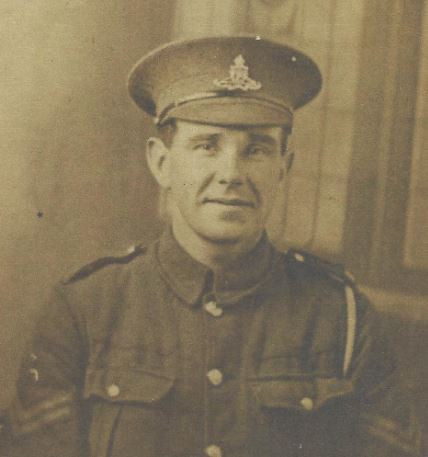Sjt
George Uren
Informationen zu Geburt
|
Geburtsdatum: 05/10/1887 |
|
Geburtsort: Newcastle upon Tyne, Northumberland, England, Vereinigtes Königreich |
Allgemeine Informationen
|
Beruf: Kutscher |
|
Religion: Church of England |
Informationen zum Armeedienst
|
Land: England, Vereinigtes Königreich |
|
Truppe: British Expeditionary Force |
|
Rang: Serjeant |
|
Dienstnummer: 27945 |
|
Einberufung ort: Newcastle upon Tyne, Northumberland, England, Vereinigtes Königreich |
|
Einheiten: — Royal Field Artillery, "B" Bty. 315th Bde. (Letzte bekannte Einheit) |
Informationen zu Tod
|
Sterbedatum: 13/09/1917 |
|
Sterbeort: Fosse Wood, Zillebeke, Belgien |
|
Todesursache: Im Kampf gefallen |
|
Alter: 29 |
Begräbnisplatz
|
The Huts Cemetery Grabstelle: V Reihe: C Grab: 14 |
Auszeichnungen und Orden 3
|
1914-15 Star Medaille — 12/03/1918 |
|
British War Medal Medaille — 07/03/1920 |
|
Victory Medal Medaille — 07/03/1920 |
Punkte von Interesse 3
| #1 | Geburtsort | ||
| #2 | Einberufung ort | ||
| #3 | Ort des Todes (ungefähr) |
Meine Geschichte
Serjeant George Uren diente in der Batterie "B" der Royal Field Artillery 315th Army Brigade, die an der dritten Schlacht von Ypern teilnahm.
Zu Beginn der Offensive waren die Batterien der Brigade in der Nähe des Kemmel Hill, gegenüber dem Messines Ridge, stationiert. Dies war nun ein relativ ruhiger Teil der Front, da die Offensive weiter nördlich wütete. Doch am 13. August 1917 rückte die Armeebrigade ins Kampfgeschehen ein. Ihre Batterien wurden der 242. Artilleriebrigade der 14. Division in der Nähe von Fosse Wood unterstellt. Am nächsten Tag begannen alle Geschütze, die deutschen Batterien, Stellungen und Nachschublinien ins Visier zu nehmen. Aber auch die deutsche Artillerie war nicht untätig und beschoss täglich die Batterien und Nachschublinien der 315. Trotz des anhaltenden deutschen Gegenbeschusses blieb die Brigade im August und September 1917 im Gebiet von Fosse Wood aktiv.
Am 13. September 1917 verlegte die Batterie "B" unter dem Befehl der 39. Divisionsartillerie von Fosse Wood in Richtung des Weilers Verbrandenmolen.
Serjeant George Uren wurde tödlich verwundet, als er die Verlegung der Batterie B organisierte. Seine sterblichen Überreste wurden ins Hinterland gebracht und auf dem nahe gelegenen The Huts Cemetery beigesetzt. Benannt nach einer Reihe von Hütten, die entlang der Straße von Dikkebus nach Brandhoek aufgereiht waren und während der Offensive von Feldambulanzen genutzt wurden.
Zu Beginn der Offensive waren die Batterien der Brigade in der Nähe des Kemmel Hill, gegenüber dem Messines Ridge, stationiert. Dies war nun ein relativ ruhiger Teil der Front, da die Offensive weiter nördlich wütete. Doch am 13. August 1917 rückte die Armeebrigade ins Kampfgeschehen ein. Ihre Batterien wurden der 242. Artilleriebrigade der 14. Division in der Nähe von Fosse Wood unterstellt. Am nächsten Tag begannen alle Geschütze, die deutschen Batterien, Stellungen und Nachschublinien ins Visier zu nehmen. Aber auch die deutsche Artillerie war nicht untätig und beschoss täglich die Batterien und Nachschublinien der 315. Trotz des anhaltenden deutschen Gegenbeschusses blieb die Brigade im August und September 1917 im Gebiet von Fosse Wood aktiv.
Am 13. September 1917 verlegte die Batterie "B" unter dem Befehl der 39. Divisionsartillerie von Fosse Wood in Richtung des Weilers Verbrandenmolen.
Serjeant George Uren wurde tödlich verwundet, als er die Verlegung der Batterie B organisierte. Seine sterblichen Überreste wurden ins Hinterland gebracht und auf dem nahe gelegenen The Huts Cemetery beigesetzt. Benannt nach einer Reihe von Hütten, die entlang der Straße von Dikkebus nach Brandhoek aufgereiht waren und während der Offensive von Feldambulanzen genutzt wurden.
Quellen 3
|
Army Troops. 315 Army Field Artillery Brigade (The National Archives, KEW (TNA), WO 95/385/8). http://www.nationalarchives.gov.uk/ Weitere Quellen |
|
British Army World War I Medal Rolls Index Cards, 1914-1920 (The National Archives, KEW (TNA), WO 372). http://www.nationalarchives.gov.uk/ Verwendete Quellen |
|
Census Returns of England and Wales, 1911 (The National Archives, Kew (TNA), RG14). http://www.nationalarchives.gov.uk/ Verwendete Quellen |
Weitere Informationen 3
|
Commonwealth War Graves Commission Database https://www.cwgc.org/find-records/find-war-dead/casualty-details/156891 |
|
Namenlijst (In Flanders Fields Museum) https://namenlijst.org/publicsearch/#/person/_id=b873c8ad-bb4d-4ef7-a8d9-62fef8d382e8 |
|
Lives of the First World War (Imperial War Museum) https://livesofthefirstworldwar.iwm.org.uk/lifestory/4541389 |
